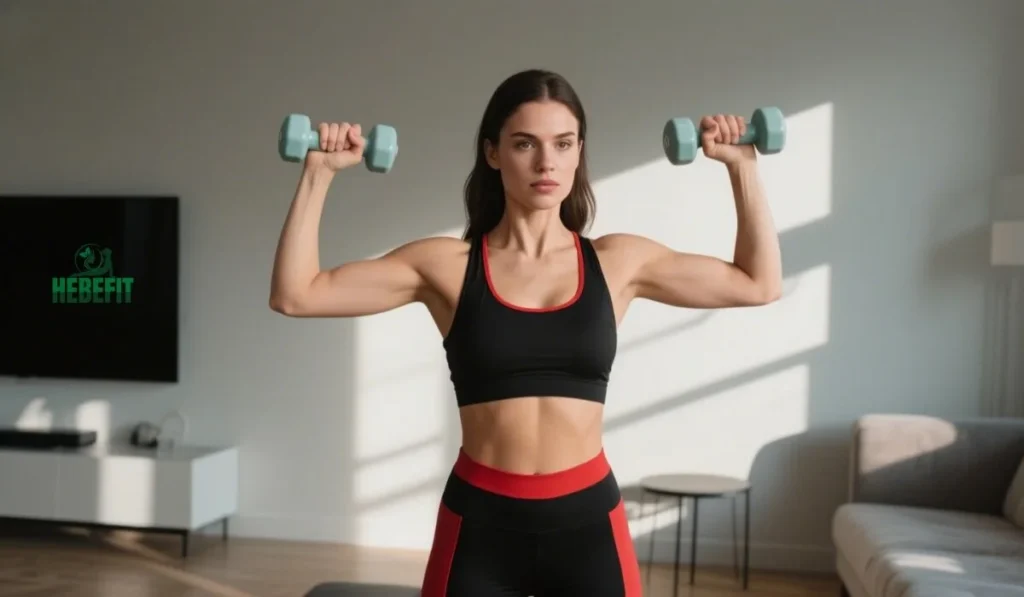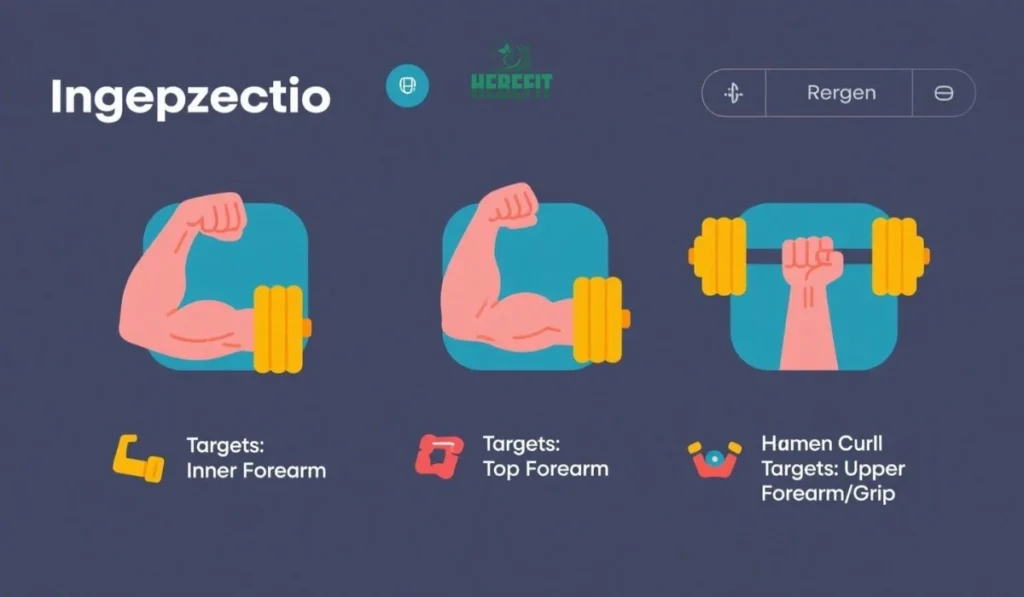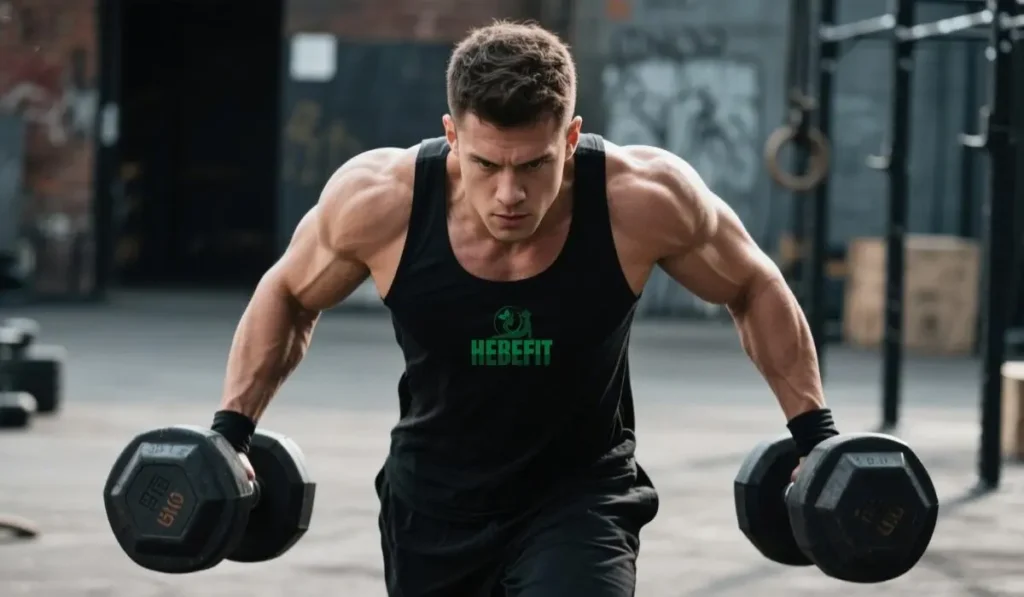Hello there and a warm welcome! Are you looking to build truly impressive arm strength and sculpt a physique that speaks of dedication? Then you’ve come to the perfect place to learn all about forearm workouts. Often, the biceps and triceps steal the limelight, but the secret to powerful, functional arms often lies in well-developed lower arms. This guide to forearm workouts is designed to be your friendly companion, showing you exactly why they matter and how to incorporate them effectively. Get ready to discover the incredible benefits and techniques of forearm workouts that can transform your grip and overall arm aesthetics!

What Exactly Are Forearm Workouts?
Before we dive deep, let’s get clear on what we mean by forearm workouts.
In simple terms, H3: Defining Forearm Workouts: Forearm workouts are a series of specific exercises designed to target and strengthen the diverse group of muscles located in your lower arms – the area between your wrist and your elbow.
These muscles are responsible for a wide array of movements, including:
- Wrist Flexion: Bending your wrist forward (palm towards your inner arm).
- Wrist Extension: Bending your wrist backward (back of your hand towards your outer arm).
- Forearm Rotation: Turning your palm up (supination) and turning your palm down (pronation).
- Grip Strength: The ability to hold onto objects tightly.
Unlike general upper body exercises where forearms might get some indirect work, dedicated forearm workouts isolate these muscles to promote specific growth, strength, and endurance in this crucial area. It’s about intentional training for targeted results!
Why Do We Need to Know About Forearm Workouts? The Compelling Reasons
You might be thinking, “Okay, I get what they are, but why should I dedicate precious workout time to my forearms?” That’s a fantastic question and the answers are quite compelling! Knowing about and implementing forearm workouts can significantly enhance your fitness journey and daily life.
Unlocking Peak Grip Strength: The Foundation of Power
This is arguably the most significant benefit!
Revolutionizing Your Lifts:
- Your ability to lift heavy in cornerstone exercises like deadlifts, rows, pull-ups, and even carrying heavy dumbbells is often limited by your grip. If your hands give out before your larger muscles do, you’re leaving serious potential gains on the table. Stronger forearms mean a more tenacious grip, allowing you to push your primary target muscles harder and longer.
Functional Fitness for Everyday Life:
- Beyond the gym, think about all the daily tasks that require a solid grip – carrying groceries, opening stubborn jars, using tools, playing sports, or even holding onto a child. Strong forearms make these activities feel noticeably easier and less strenuous.
Sculpting Aesthetically Pleasing and Balanced Arms
While function is king, let’s be honest – well-developed forearms look fantastic!
Completing the Arm:
Muscular forearms create a sense of symmetry and proportion, bridging the visual gap between powerful upper arms and your hands. They signal a holistic approach to training and attention to detail.
The Visual Mark of Strength:
Even in a t-shirt, well-defined forearms can be an impressive visual cue of your strength and fitness dedication.
Enhancing Injury Prevention and Joint Stability
Stronger forearms contribute to healthier, more resilient wrists and elbows.
Protecting Your Wrists:
The muscles in your forearms are the primary stabilizers of your wrist joint. Strengthening them helps make your wrists more robust and less prone to sprains or strains, especially when handling heavy weights or engaging in dynamic movements.
Supporting Elbow Health:
Several forearm muscles cross the elbow joint. Balanced strength between your forearm flexors and extensors can contribute to better elbow tracking and may help reduce the risk of common overuse issues like tennis elbow or golfer’s elbow. Investing in forearm strength is investing in your joint longevity.
Boosting Athletic Performance Across Disciplines
Many sports rely heavily on the power and endurance of your forearms and grip.
- Edge in Sports: From rock climbing and martial arts to tennis, golf, baseball, and swimming, strong forearms can directly translate to improved performance, control, and power output.
Knowing about forearm workouts isn’t just about building bigger muscles; it’s about unlocking a new level of functional strength, aesthetic balance, and injury resilience that benefits almost every aspect of your physical life.
How to Do Forearm Workouts: Your Exercise Blueprint
Alright, let’s get to the exciting part – the “how-to”! We’ll explore a variety of effective exercises to build well-rounded, powerful forearms. Remember to start with weights that allow you to maintain perfect form and always warm up your wrists and elbows with some gentle circles and movements before you begin.
Targeting the Wrist Flexors (Building Inner Forearm Mass)
These muscles are on the palm-side of your forearm and are key for gripping and curling your wrist forward.
The Classic Wrist Curl (Using Dumbbells or Barbell)
- How to Perform:
- Sit comfortably on a bench, resting your forearms on your thighs (or across a flat bench if you prefer), with your palms facing upwards.
- Hold a dumbbell in each hand (or a barbell with both hands). Allow your wrists to extend fully downwards, letting the weight roll towards your fingertips to get a good stretch in your inner forearms.
- Smoothly curl the weight upwards by flexing only your wrists, squeezing your forearm muscles intensely at the top of the movement.
- Lower the weight slowly and with complete control back to the starting position.
- Friendly Tip: Dumbbells allow for a more natural range of motion and can help identify/correct strength imbalances between arms. Focus on feeling the muscle work rather than just moving weight.
Behind-the-Back Barbell Wrist Curl
- How to Perform:
- Stand tall, holding a barbell behind your back with an underhand grip (palms facing away from your body).
- Let the bar roll down towards your fingertips, then curl the bar back up by flexing your wrists.
- Friendly Tip: This variation can offer a unique stretch and contraction. Ensure your shoulders are comfortable with this movement.
Engaging the Wrist Extensors (Developing Top Forearm Muscles)
These muscles are on the top-side of your forearm and are crucial for bending your wrist backward and stabilizing it.
The Essential Reverse Wrist Curl (Using Dumbbells or Barbell)
- How to Perform:
- The setup is similar to the regular wrist curl, but this time, your palms should be facing downwards.
- Rest your forearms on your thighs or a bench. Allow your wrists to bend downwards, lowering the weight.
- Now, extend your wrists upwards, lifting the weight as high as you comfortably can. Feel the contraction in the muscles on the top of your forearms.
- Lower slowly and with deliberate control.
- Friendly Tip: You will use significantly lighter weights for reverse wrist curls compared to regular wrist curls. This is normal! Focus on form and control. This exercise is vital for balanced forearm development and preventing wrist issues.
Building the Brachioradialis & Overall Forearm Thickness
The brachioradialis is a prominent muscle on the thumb-side of your upper forearm that contributes significantly to its size.
Hammer Curls: The Arm Sculptor
- How to Perform:
- Stand or sit tall, holding a dumbbell in each hand with a neutral grip (palms facing each other, as if you’re holding hammers).
- Keeping your elbows relatively stationary at your sides, curl the dumbbells straight up towards your shoulders.
- Squeeze at the top, focusing on the contraction in your upper arms and especially the brachioradialis.
- Lower the dumbbells slowly and under full control.
- Friendly Tip: This is an excellent exercise not just for forearms but also for the brachialis muscle (which lies beneath the bicep and adds arm thickness) and the biceps.
Reverse Barbell Curls (Straight or EZ-Bar)
- How to Perform:
- Stand holding a barbell (a straight bar or an EZ-curl bar, which can be more wrist-friendly) with an overhand grip (palms facing down), about shoulder-width apart.
- Keeping your elbows tucked in, curl the bar up towards your shoulders.
- Focus on keeping your wrists straight or even slightly flexed (bent downwards) to maximize brachioradialis and forearm extensor engagement.
- Lower the bar slowly and with control.
- Friendly Tip: Again, use a lighter weight than you would for standard bicep curls. This really targets that “Popeye” muscle!

Forging an Unbreakable Grip:
Dedicated Strength Exercises
Farmer’s Walks: The Ultimate Test of Grip & Grit
- How to Perform:
- Select a pair of heavy dumbbells, kettlebells, or specialized farmer’s walk handles.
- With a proud chest and braced core, safely deadlift the weights up and hold them firmly at your sides.
- Walk for a set distance or time, maintaining a vice-like grip and an upright posture. Take purposeful, controlled steps.
- Friendly Tip: This is one of the best all-around grip builders and also works your traps, core, and legs. Simple, but incredibly effective!
Dead Hangs: Simple, Potent, and Decompressive
- How to Perform:
- Grasp a pull-up bar with an overhand grip (palms facing away), slightly wider than shoulder-width.
- Simply hang from the bar with your arms fully extended for as long as you can maintain your grip.
- Try to keep your shoulders slightly active (scapulae pulled down and back a bit).
- Friendly Tip: Great for grip endurance and it also provides a nice spinal decompression.
Table 1: Sample Forearm Workout Integration
This table shows how you might add forearm exercises as a “finisher” to your existing workouts.
| Workout Day Focus | Forearm Finisher (Choose 2-3 exercises) | Sets & Reps/Duration |
| Upper Body / Pull | Wrist Curls, Reverse Wrist Curls, Dead Hangs | 3 sets of 12-15 reps / Max hold |
| Arms Day | Hammer Curls, Zottman Curls, Plate Pinches | 3 sets of 10-15 reps / Timed holds |
| Full Body | Farmer’s Walks (as part of workout or finisher), Wrist Curls | 3 sets of 30-60 sec walks / 12-15 reps |
Remember, this is just a sample. Adjust based on your overall program and recovery.
The Wonderful Benefits of Forearm Workouts
We’ve touched on some of these, but let’s consolidate the amazing advantages you gain from incorporating dedicated forearm workouts into your routine. The payoff is well worth the effort!
Skyrocketed Grip Strength
- Enhanced Lifting Capacity: Hold onto heavier weights for longer, breaking through plateaus in your major compound lifts.
- Improved Muscular Endurance: Perform more repetitions before your grip fatigues, allowing for greater training volume.
Impressive Arm Aesthetics & Symmetry
- Fuller, More Developed Arms: Forearms that match the development of your biceps and triceps create a more complete and powerful look.
- Increased Vascularity: For those who appreciate it, dedicated forearm work can often lead to increased vascularity over time.
Reduced Risk of Injury
- Stronger, More Stable Wrists: Less likelihood of sprains or strains during dynamic movements or when handling heavy objects.
- Better Elbow Health: Balanced forearm strength can help mitigate common elbow issues related to overuse or imbalances.
Improved Performance in Sports & Daily Life
- Greater Athletic Prowess: Excel in sports requiring strong hands and wrists, from climbing and combat sports to racket sports.
- Everyday Tasks Made Easier: Feel more capable and confident in your daily physical activities. It’s truly empowering!
Table 2: Forearm Exercise Quick Reference Guide
| Exercise | Primary Target Area(s) | Equipment Needed | Difficulty |
| Wrist Curl | Inner Forearm (Flexors) | Dumbbell/Barbell | Beginner |
| Reverse Wrist Curl | Top Forearm (Extensors) | Dumbbell/Barbell | Beginner |
| Hammer Curl | Upper Forearm (Brachioradialis), Biceps | Dumbbells | Beginner |
| Reverse Barbell Curl | Upper Forearm, Extensors | Barbell/EZ-Bar | Intermediate |
| Farmer’s Walk | Overall Grip, Full Body | Heavy DBs/KBs/Handles | All Levels |
| Dead Hang | Grip Endurance | Pull-up Bar | All Levels |

Final Thoughts: Embrace the Power in Your Grip
Dedicating time to forearm workouts is an investment that pays dividends far beyond just the appearance of your lower arms. It’s about building true, functional strength that translates into better performance in all your lifts, enhanced capability in daily life, and a more resilient, injury-proof body.
Start slow, focus on impeccable form, and be consistent. Listen to your body, and don’t be afraid to challenge yourself gradually. The journey to stronger, more developed forearms is incredibly rewarding, and the newfound power you’ll feel in your hands will be a constant reminder of your dedication. So, roll up those sleeves and get ready to build some seriously impressive forearms!
FAQs: Your Forearm Workout Questions Answered
We know you might have some more questions, so let’s tackle some common ones to help you feel even more confident!
How long does it typically take to see noticeable results from forearm workouts?
Answer: Great question! You’ll likely feel an improvement in your grip strength and endurance within 3-4 weeks of consistent training. Visible muscle growth (hypertrophy) generally takes a bit longer. You might start noticing some subtle changes in size or definition around the 6-8 week mark, with more significant and impressive results building up over several months of dedicated effort and proper nutrition. Patience and consistency are your best allies!
Is it a good idea to train my forearms every single day for faster growth?
Answer: While it might seem like more is always better, it’s generally not recommended to train your forearms with direct, intense exercises every day. Like all muscles, your forearms need adequate time to recover, repair, and grow stronger. Overtraining can lead to diminished returns, tendonitis, or other overuse injuries. Sticking to 2-3 focused forearm workout sessions per week is usually optimal, allowing at least 48 hours of rest for them between direct workouts.
Are wrist wraps actually bad for my forearm development if I use them?
Answer: Wrist wraps can be a useful tool for providing extra support and stability to your wrists during very heavy pressing movements (like maximal bench presses or overhead presses), which can help prevent wrist hyperextension. However, if you become overly reliant on them for exercises where developing grip strength is also a primary or secondary goal (like deadlifts, rows, or even some curls when not attempting a true one-rep max), they can indeed hinder your natural forearm and grip strength development. Use them strategically and judiciously, not as a constant crutch for all your lifts.
Do I absolutely need a lot of special gym equipment for effective forearm workouts?
Answer: Not at all! While barbells, dumbbells, and specialized grip tools are certainly beneficial, you can get a highly effective forearm workout with minimal or even no traditional gym equipment. Think about bodyweight options and simple tools:
* Dead Hangs (from a pull-up bar, sturdy tree branch, or even playground equipment)
* Towel Hangs or Rows (draping a towel over a bar makes the grip incredibly challenging for your forearms)
* Plate Pinches (if you have access to a couple of weight plates)
* Fingertip Push-ups (excellent for finger and wrist strength)
* Even a rice bucket workout (performing various hand and wrist movements in a bucket filled with uncooked rice) can be surprisingly potent for endurance and hitting smaller muscles! Resourcefulness is key!
Are forearm workouts mainly beneficial for men, or can women get great results too?
Answer: Forearm workouts are absolutely beneficial for everyone, regardless of gender! Strong, functional forearms and a capable grip offer immense advantages for women in sports, daily activities (like carrying children, groceries, or luggage), and for achieving overall fitness, confidence, and a balanced physique. Women generally will not develop overly bulky or “masculine” forearms unless they are specifically and intensely training and dieting for extreme levels of muscle growth, due to natural hormonal differences. The goal for most is functional strength, improved muscle tone, and a feeling of everyday capability.
What should I do if I start experiencing pain in my wrists or elbows during or after forearm exercises?
Answer: The first and most important step is to stop the exercise that is causing pain. Pain is your body’s signal that something isn’t right. Then, consider these steps:
1. Assess your form meticulously: Are you using too much weight, moving too quickly, or using an incorrect range of motion?
2. Ensure you’re warming up thoroughly: Your wrists and elbows need to be adequately prepared.
3. Reduce the weight/intensity significantly: Try a much lighter weight or fewer repetitions when you attempt the exercise again after some rest.
4. Allow for adequate rest and recovery: Give the affected area a break from direct forearm work for a few days.
If the pain is sharp, persists for more than a few days despite rest, or worsens, it’s always best to consult with a doctor or a qualified physical therapist to get an accurate diagnosis and appropriate guidance. Don’t try to push through persistent pain.
How can I tell if my forearms are a particular weak link in my overall training?
Answer: Some good indicators that your forearms might need more dedicated attention include:
* Your grip consistently failing on major lifts like deadlifts, rows or pull-ups before your larger target muscles (like your back, legs, or biceps) feel adequately fatigued.
* Regularly struggling with everyday tasks that require decent grip strength (e.g., difficulty opening jars, hands fatiguing quickly when carrying heavy items).
* Your forearms appearing visibly underdeveloped or disproportionately small compared to your upper arms, creating an aesthetic imbalance.
* Finding specific grip-intensive exercises (like farmer’s walks or dead hangs) extremely challenging even with what seems like relatively light weights or short durations for others.
How much does genetics really play a role in forearm size and strength potential? Can I still build them if I feel I have “bad” genetics for forearms?
Answer: Genetics do play a role in muscle belly length, tendon insertion points, natural wrist circumference, and an individual’s overall predisposition to muscle growth in any body part, including the forearms. Some people might naturally have thicker forearms or find it easier to develop them due to these factors. However, please do not let this discourage you in any way! Regardless of your genetic starting point, virtually everyone can achieve significant and meaningful improvements in both the strength and size of their forearms with consistent, intelligent training, proper nutrition and adequate rest. Focus on the factors you can control – your effort, your exercise selection, your technique and your consistency – and you will see positive changes and build impressive forearms.











3 thoughts on “Forearm Workouts”